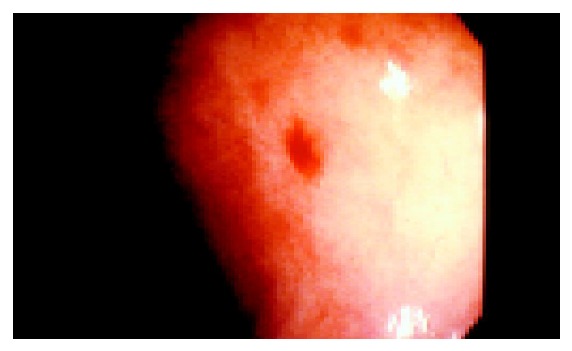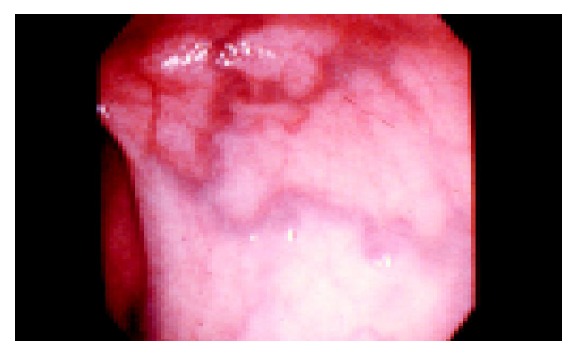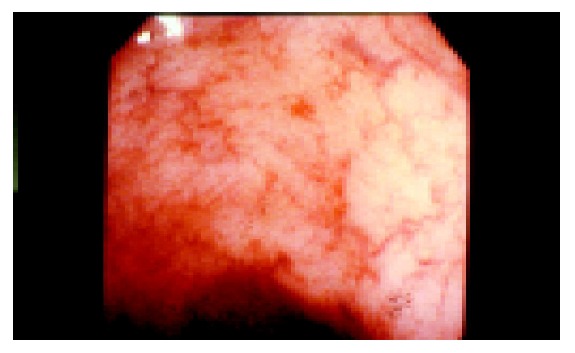Abstract
AIM: In patients with liver cirrhosis and portal hypertension, portal hypertensive colopathy is thought to be an important cause of lower gastrointestinal hemorrhage. In this study, we evaluated the prevalence of colonic mucosal changes in patients with liver cirrhosis and its clinical significance.
METHODS: We evaluated the colonoscopic findings and liver function of 47 patients with liver cirrhosis over a 6-year period. The main cause of liver cirrhosis was post-viral hepatitis (68%) related to hepatitis B (6%) or C (62%) infection. All patients underwent upper gastrointestinal endoscopy to examine the presence of esophageal varices, cardiac varices, and congestive gastropathy, as well as a full colonoscopy to observe changes in colonic mucosa. Portal hypertensive colopathy was defined endoscopically in patients with vascular ectasia, redness, and blue vein. Vascular ectasia was classified into two types: type 1, solitary vascular ectasia; and type 2, diffuse vascular ectasia.
RESULTS: Overall portal hypertensive colopathy was present in 31 patients (66%), including solitary vascular ectasia in 17 patients (36%), diffuse vascular ectasia in 20 patients (42%), redness in 10 patients (21%) and blue vein in 6 patients (12%). As the Child-Pugh class increased in severity, the prevalence of portal hypertensive colopathy rose. Child-Pugh class B and C were significantly associated with portal hypertensive colopathy. Portal hypertensive gastropathy, esophageal varices, ascites and hepatocellular carcinoma were not related to occurrence of portal hypertensive colopathy. Platelet count was significantly associated with portal hypertensive colopathy, but prothrombin time, serum albumin level, total bilirubin level and serum ALT level were not related to occurrence of portal hypertensive colopathy.
CONCLUSION: As the Child-Pugh class worsens and platelet count decreases, the prevalence of portal hypertensive colopathy increases in patients with liver cirrhosis. A colonoscopic examination in patients with liver cirrhosis is indicated, especially those with worsening Child-Pugh class and/or decreasing platelet count, to prevent complications such as lower gastrointestinal bleeding.
Keywords: Portal hypertensive colopathy, Liver cirrhosis
INTRODUCTION
Liver cirrhosis causes multiple complications, including esophageal varices due to portal hypertension. In comparison with alcohol-related etiologies of liver cirrhosis in Europe and America, liver cirrhosis due to post-viral infection, especially HCV infection, is more predominant in Japan. In patients with liver cirrhosis and portal hypertension, varices of the esophagus, stomach and portal hypertensive gastropathy are well described[1-3]. These complications are the most common causes of gastrointestinal hemorrhage. Recently, colorectal mucosal lesions in patients with liver cirrhosis were reported as portal hypertensive colopathy[4-7]. These are thought to be important causes of lower gastrointestinal hemorrhage[8], although the clinical importance of these lesions in patients with portal hypertensive colopathy is not well established. In this study, we evaluated the prevalence of colonic mucosal changes in patients with liver cirrhosis, especially that due to post-viral infection HCV, and its clinical significance.
MATERIALS AND METHODS
Patients
We evaluated the liver function and colonoscopic findings in 47 patients with liver cirrhosis over a 6-year period. Liver cirrhosis was confirmed by histology or by compatible physical findings, laboratory data, and radiographic features. The etiologies of cirrhosis are shown in Table 1. The main cause of liver cirrhosis was post-viral hepatitis (68%) related to hepatitis B (6%) or C (62%) infection. In addition, 13 patients (27%) had hepatocellular carcinoma.
Table 1.
Etiologies of liver cirrhosis.
| Diagnosis | Patients (n) |
| HCV | 29 |
| HBV | 3 |
| Non-B non-C | 5 |
| Alcohol | 5 |
| AIH | 3 |
| PBC | 2 |
AIH: autoimmune hepatitis, PBC: primary biliary cirrhosis.
Methods
An upper gastrointestinal endoscopy was performed in all patients to evaluate the presence of esophageal varices, cardiac varices, and congestive gastropathy. Liver disease severity was assessed according to Child-Pugh’s classification. All patients underwent a full colonoscopy with anti-cholinergic drugs, after preparation with polyethylene glycol electrolyte solution. Noted changes in colonic mucosa included the number, size, and location of vascular lesions. Portal hypertensive colopathy was defined endoscopically in patients with vascular ectasia, redness (Figure 1), and blue vein (Figure 2). Vascular ectasia was further classified into two types: type 1, solitary vascular ectasia (Figure 3); and type 2, diffuse vascular ectasia (Figure 4). Results from multiple, independent observers were compiled to determine the prevalence of portal hypertensive colopathy.
Figure 1.

Colonoscopic examination shows redness.
Figure 2.

Colonoscopic examination shows a blue vein.
Figure 3.

Colonoscopic examination shows a solitary vascular ectasia.
Figure 4.

Colonoscopic examination shows diffuse vascular ectasia.
Statistical analyses
Data are expressed as mean±SD. Statistical comparisons were made with the χ2 test. A P value less than 0.05 was considered significant.
RESULTS
In our cirrhotic patients, the primary indications for colonoscopy included a positive fecal occult blood test in 16 (34%), melena in 11 (23%), iron deficiency anemia in 5 (10%), diarrhea in 2 (4%), abdominal pain in 2 (4%), high level of serum CEA in 2 (4%), and screening in 5 (10%) patients. Overall portal hypertensive colopathy was present in 31 patients (66%), whereas vascular ectasia was observed in 17 (36%), diffuse vascular ectasia in 20 (42%), redness in 10 (21%) and blue vein in 6 (12%) patients.
The clinical characteristics of the cirrhotic patients with or without portal hypertensive colopathy are shown in Table 2. As the Child-Pugh class worsened, the prevalence of portal hypertensive colopathy increased. Child-Pugh class B and C were significantly associated with portal hypertensive colopathy. Portal hypertensive gastropathy, esophageal varices, hepatocellular carcinoma, and presence of ascites were not related to occurrence of portal hypertensive colopathy.
Table 2.
Characteristics of the 47 patients.
| PHC-positive n = 31 (%) | PHC-negative n = 16 (%) | P | ||
| Age (yr) | 62.5±7.3 | 61.6±9.7 | NS | |
| Sex | (M:F) | 18:13 | 13:3 | NS |
| Child–Pugh | (A:B+C) | 11:20 | 12:4 | P<0.05 |
| PHG | None | 23 (76.7) | 10 (62.5) | NS |
| Mild | 5 | 5 | NS | |
| Severe | 2 | 1 | NS | |
| Ascites | 3 (9.7) | 1 (6.3) | NS | |
| Splenomegaly | 24 (77.4) | 11 (68.8) | NS | |
| Alcohol | 4 (12.9) | 3 (18.8) | NS | |
| HCC | 7 (22.6) | 6 (37.5) | NS | |
| EG varices | 17 (54.8) | 5 (31.3) | NS |
PHC: portal hypertensive colopathy, PHG: portal hypertensive gastropathy, HCC: hepatocellular carcinoma, EG varices: esophago-gastric varices.
The laboratory data of these patients are shown in Table 3. Platelet count but not serum ALT level was significantly associated with portal hypertensive colopathy. The prothrombin time as well as serum albumin and total bilirubin levels were not related to the occurrence of portal hypertensive colopathy.
Table 3.
Laboratory data of the 47 patients.
| PHC-positive n = 31 | PHC-negative n = 16 | P | |
| Prothrombin time (%) | 74.0±15.7 | 81.4±21.7 | NS |
| ALT (IU/L) | 51.1±33.8 | 55.9±41.8 | NS |
| Platelet (×104/mm3) | 8.3±4.3 | 12.1±5.1 | P<0.05 |
| Serum albumin (g/dL) | 3.2±0.6 | 3.4±0.5 | NS |
| Total bilirubin (mg/dL) | 1.55±0.94 | 1.08±0.73 | NS |
| Cholinesterase (rpH) | 0.48±0.27 | 0.55±0.21 | NS |
| ICG R15 | 30.5±15.4 | 25.0±9.6 | NS |
ICG R15: indocyanine green retention rate at 15 min.
DISCUSSION
Various vascular abnormalities have been observed in the mucosa of upper gastrointestinal tract of cirrhotic patients, including gastroesophageal varices and gastric antral vascular ectasia[1-3]. These vascular lesions account for most of the upper gastrointestinal bleeding in cirrhotic patients. Similarly, vascular ectasias and varices may occur in the colonic mucosa of cirrhotic patients, and bleeding from these vascular lesions was reported[4,5]. In the present study, portal hypertensive colopathy was present in 66% (31/47) of the cirrhotic patients. Several studies have described the colonic findings associated with cirrhosis and portal hypertension was observed in 50-84% patients with liver cirrhosis[6-15]. Histologic examination of rectal mucosal lesions in patients with liver cirrhosis revealed dilatation of blood vessels in the mucosa, increased lymphocytes and plasma cells in the lamina propria, and edema of the mucosa[4,7]. In our study, portal hypertensive colopathy was found in 23% of patients in rectosigmoid colon, 11% in the descending colon, 24% in the transverse colon, 23% in the ascending colon and 16% in the cecum.
We classified the portal hypertensive colopathy into four types. Solitary vascular ectasias were found predominantly in the transverse and ascending colon (55%). Diffuse vascular ectasias were found predominantly in the right side colon (45%). Redness was found in the overall colon and blue vein in the rectum. In contrast to prior studies[4,6-10,12-14]. Our data demonstrated that the prevalence of portal hypertensive colopathy increased with worsening Child-Pugh class. The association with Child-Pugh class may be a result of increased hemodynamic dysfunction in those with more advanced liver disease. A decreased platelet count was also related to occurrence of portal hypertensive colopathy, which to our knowledge has not been reported previously. It is possible that the concurrent low platelet count and portal hypertensive colopathy may be due to a relatively high number of patients with post-viral infection in this Japanese cohort as post-viral liver cirrhosis decreases platelet count more than alcoholic liver cirrhosis does.
Child-Pugh class A, presence of ascites, prothrombin time, serum albumin level, and total bilirubin level were not related to occurrence of portal hypertensive colopathy. However, as Child-Pugh class worsened, the prevalence of portal hypertensive colopathy correspondingly increased. Synthetic liver function is important for the prevalence of portal hypertensive colopathy. Similar to the prior studies[16-18], we also observed that esophageal varices were not related to portal hypertensive colopathy. Portal hypertensive colopathy may not be a distinct entity but, rather, a regional manifestation of portal hypertension[15]. Lower gastrointestinal bleeding is the major complication of portal hypertensive colopathy. In our study, active oozing colonic lesions were found in two cases of 11 cirrhotic patients with melena. These patients underwent endoscopic clipping for treatment of active bleeding, but bleeding recurred. Each case was Child-Pugh class B and had decreasing platelet count. Therefore, we suggest that a colonoscopic examination should be performed in patients with liver cirrhosis, especially those with worsening Child-Pugh class and decreasing platelet count.
In conclusion, as the Child-Pugh class worsens and platelet count decreases, the prevalence of portal hypertensive colopathy increases in patients with liver cirrhosis. Colonoscopic examination is needed in these patients, especially those with worsening Child-Pugh class and decreasing platelet count, to prevent complications, such as lower gastrointestinal bleeding.
References
- 1.Viggiano TR, Gostout CJ. Portal hypertensive intestinal vasculopathy: a review of the clinical, endoscopic, and histopathologic features. Am J Gastroenterol. 1992;87:944–954. [PubMed] [Google Scholar]
- 2.Arendt T, Barten M, Lakner V, Arendt R. Diffuse gastric antral vascular ectasia: cause of chronic gastrointestinal blood loss. Endoscopy. 1987;19:218–220. doi: 10.1055/s-2007-1018287. [DOI] [PubMed] [Google Scholar]
- 3.Gostout CJ, Viggiano TR, Balm RK. Acute gastrointestinal bleeding from portal hypertensive gastropathy: prevalence and clinical features. Am J Gastroenterol. 1993;88:2030–2033. [PubMed] [Google Scholar]
- 4.Kozarek RA, Botoman VA, Bredfeldt JE, Roach JM, Patterson DJ, Ball TJ. Portal colopathy: prospective study of colonoscopy in patients with portal hypertension. Gastroenterology. 1991;101:1192–1197. doi: 10.1016/0016-5085(91)90067-u. [DOI] [PubMed] [Google Scholar]
- 5.Naveau S, Bedossa P, Poynard T, Mory B, Chaput JC. Portal hypertensive colopathy. A new entity. Dig Dis Sci. 1991;36:1774–1781. doi: 10.1007/BF01296624. [DOI] [PubMed] [Google Scholar]
- 6.Tam TN, NG WW, Lee SD. Colonic mucosal changes in patients with liver cirrhosis. Gastrointest Endosc. 1995;42:408–412. doi: 10.1016/s0016-5107(95)70040-4. [DOI] [PubMed] [Google Scholar]
- 7.Bini EJ, Lascarides CE, Micale PL, Weinshel EH. Mucosal abnormalities of the colon in patients with portal hypertension: an endoscopic study. Gastrointest Endosc. 2000;52:511–516. doi: 10.1067/mge.2000.108478. [DOI] [PubMed] [Google Scholar]
- 8.Weinshel E, Chen W, Falkenstein DB, Kessler R, Raicht RF. Hemorrhoids or rectal varices: defining the cause of massive rectal hemorrhage in patients with portal hypertension. Gastroenterology. 1986;90:744–747. doi: 10.1016/0016-5085(86)91132-7. [DOI] [PubMed] [Google Scholar]
- 9.Wang M, Desigan G, Dunn D. Endoscopic sclerotherapy for bleeding rectal varices: a case report. Am J Gastroenterol. 1985;80:779–780. [PubMed] [Google Scholar]
- 10.Wilson SE, Stone RT, Christie JP, Passaro E. Massive lower gastrointestinal bleeding from intestinal varices. Arch Surg. 1979;114:1158–1161. doi: 10.1001/archsurg.1979.01370340064011. [DOI] [PubMed] [Google Scholar]
- 11.Chen LS, Lin HC, Lee FY, Hou MC, Lee SD. Portal hypertensive colopathy in patients with cirrhosis. Scand J Gastroenterol. 1996;31:490–494. doi: 10.3109/00365529609006770. [DOI] [PubMed] [Google Scholar]
- 12.Rabinovitz M, Schade RR, Dindzans VJ, Belle SH, Van Thiel DH, Gavaler JS. Colonic disease in cirrhosis. An endoscopic evaluation in 412 patients. Gastroenterology. 1990;99:195–199. doi: 10.1016/0016-5085(90)91248-5. [DOI] [PubMed] [Google Scholar]
- 13.Scandalis N, Archimandritis A, Kastanas K, Spiliadis C, Delis B, Manika Z. Colonic findings in cirrhotics with portal hypertension. A prospective colonoscopic and histological study. J Clin Gastroenterol. 1994;18:325–328; discussion 329. doi: 10.1097/00004836-199406000-00014. [DOI] [PubMed] [Google Scholar]
- 14.Goenka MK, Kochhar R, Nagi B, Mehta SK. Rectosigmoid varices and other mucosal changes in patients with portal hypertension. Am J Gastroenterol. 1991;86:1185–1189. [PubMed] [Google Scholar]
- 15.Ganguly S, Sarin SK, Bhatia V, Lahoti D. The prevalence and spectrum of colonic lesions in patients with cirrhotic and noncirrhotic portal hypertension. Hepatology. 1995;21:1226–1231. [PubMed] [Google Scholar]
- 16.Misra SP, Dwivedi M, Misra V. Prevalence and factors influencing hemorrhoids, anorectal varices, and colopathy in patients with portal hypertension. Endoscopy. 1996;28:340–345. doi: 10.1055/s-2007-1005477. [DOI] [PubMed] [Google Scholar]
- 17.Bresci G, Gambardella L, Parisi G, Federici G, Bertini M, Rindi G, Metrangolo S, Tumino E, Bertoni M, Cagno MC, et al. Colonic disease in cirrhotic patients with portal hypertension: an endoscopic and clinical evaluation. J Clin Gastroenterol. 1998;26:222–227. doi: 10.1097/00004836-199804000-00016. [DOI] [PubMed] [Google Scholar]
- 18.Yamakado S, Kanazawa H, Kobayashi M. Portal hypertensive colopathy: endoscopic findings and the relation to portal pressure. Intern Med. 1995;34:153–157. doi: 10.2169/internalmedicine.34.153. [DOI] [PubMed] [Google Scholar]


